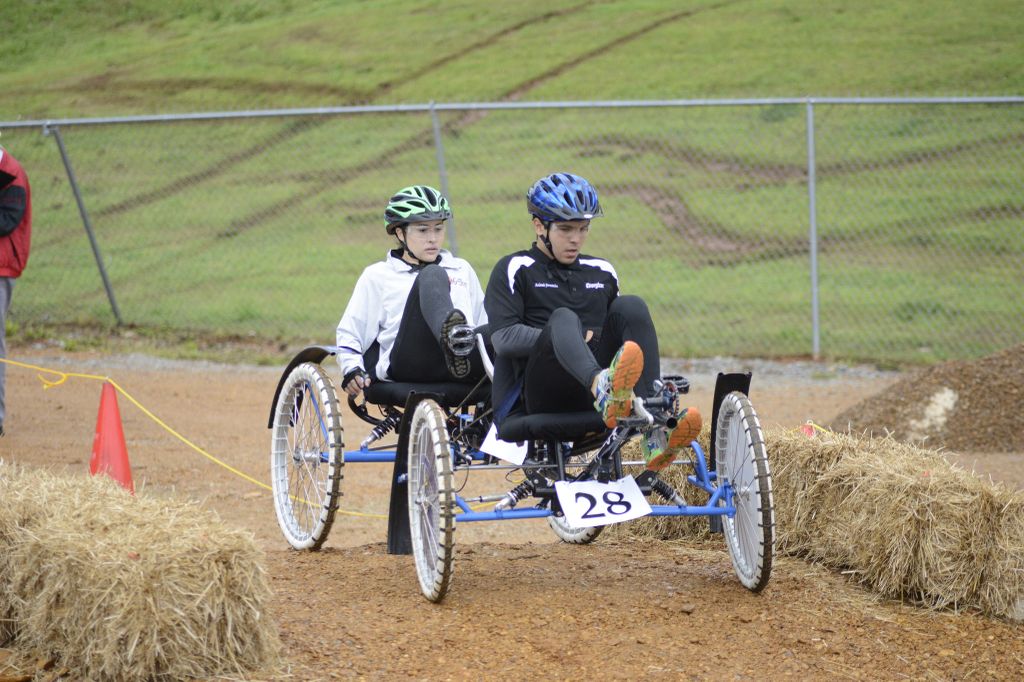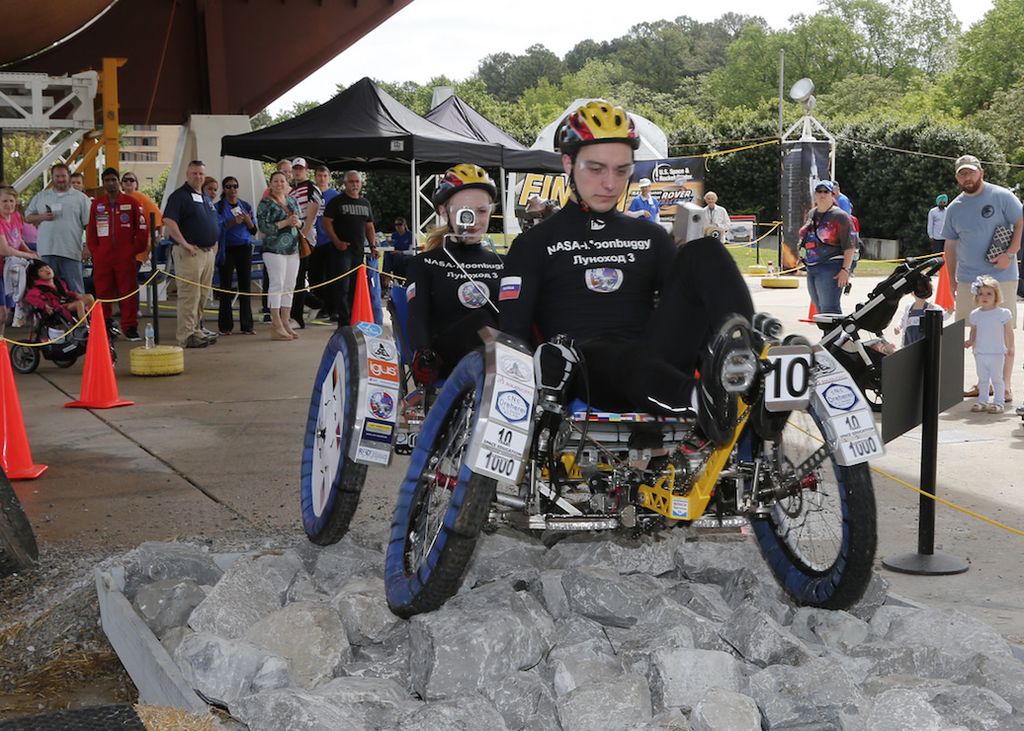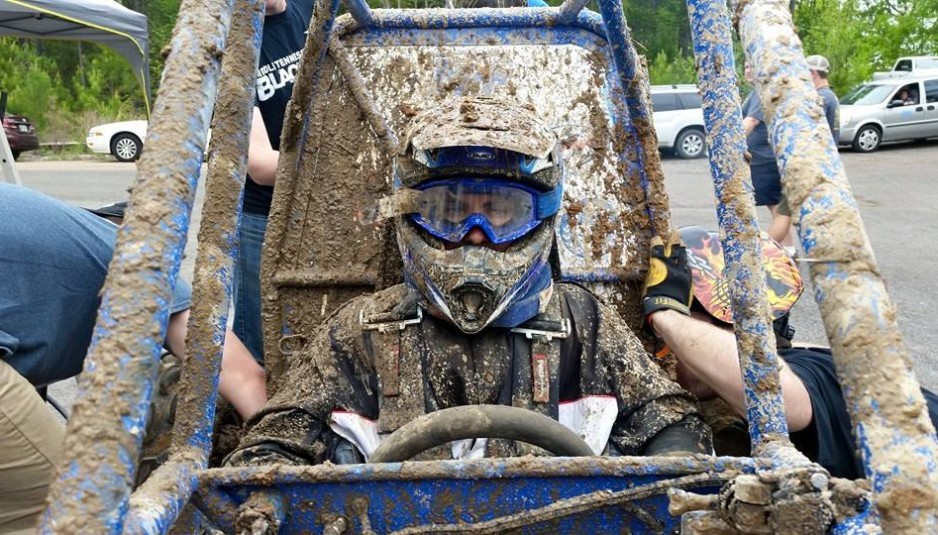
Every year since 1994, high school and college teams from around the world have converged on NASA's Marshall Space Flight Center in Huntsville, Alabama to compete in the Human Exploration Rover Challenge (HERC). Designed to inspire students to solve the same kinds of engineering problems routinely faced by NASA engineers who design rovers for future exploration missions, the competition also highlights NASA's commitment to inspiring new generations of scientists, engineers and explorers.
Formerly known as the Great Moonbuggy Race, and inspired by the Lunar Roving Vehicles of the Apollo moon missions, this competition challenged students to design, build, and race human-powered rovers through simulated lunar environments. However, as of last year, the mandate of the race expanded to include the exploration of other extra-terrestrial environments - such as Mars, other moons, and even asteroids.
This year, the competition ran from April 17th to 18th at the U.S. Space and Rocket Center in Hunstville, Alabama. Close to 100 high school and college students assembled to race against each other, with teams coming from 15 US states and Puerto Rico, as well as Mexico, Germany, India and Russia. As always, the competition consisted of four-wheeled rovers, similar to tandem bicycles built on a go-cart frame, that were manned by a male-female couple who raced them through simulated terrain.

Winners in the high school division went to the team from University Gardens High School of San Juan, Puerto Rico. Credit: NASA/MSFC/Emmett Given
In previous years, the course was designed to simulate lunar terrain. But this year, the course was expanded to feature a total of 17 unique obstacles that are shaped to resemble craters, basins, boulders, ancient lava flows, crevasses, and other things common to extra-terrestrial landscapes. The course also has simulated fields of asteroid debris, boulders of varying sizes, an ancient stream bed filled with pebbles, and erosion ruts and crevasses.
Each team was responsible for finishing the 1.2 km (three-quarter-mile) obstacle course in the fastest time, vying for prizes in various divisions. The event concluded on April 18th with a ceremony held in the Davidson Center for Space Exploration, where corporate sponsors present awards for the best design, rookie team and other accomplishments. This year, the top prizes for the Challenge were taken home by teams from Puerto Rico and Russia.
The University Gardens High School team from San Juan, Puerto Rico won first place in the high school division while the International Space Education Institute team of Moscow, Russia, won in the college division. At the end of the two-day challenge, at the U.S. Space & Rocket Center in Huntsville, both teams posted the fastest vehicle assembly and race times in their divisions, while incurring the fewest on-course penalties.

First place in the college division went to team Russia from the International Space Education Institute of Moscow. Credit: NASA/MSFC/Emmett Given
Hot on their heels was another Puerto Rican student team, this one from Rafaelina Lebron Flores secondary school in Patillas, while third place went to the team from The Academy of Arts, Careers & Technology in Reno, Nevada. Meanwhile, second and third place in the college division went to the International Space Education Institute (in Leipzig, Germany) and Middle Tennessee State University.
In addition to taking home the winning trophies, both first-place teams also received a cash prize of $3,000, courtesy of the Challenge's corporate sponsor, The Boeing Company. In addition, other awards were presented for accomplishments regarding technology design, systems safety and more. These included the Neil Armstrong Best Design Award for the best technical approach to solving the engineering problem of navigating the extraterrestrial course terrain.
The first place winners for this award included the Parish Episcopal School from Dallas, Texas (in the high school division) and the Auburn University team from Auburn, Alabama, in the university division. The Frank Joe Sexton Memorial Pit Crew Award - which is awarded for ingenuity and persistence in overcoming problems during the race, and named after a NASA welder who died in 2000 - was claimed by the Centro de de Ciencia y Tecnologia Semilla of Chihuahua, Mexico in the high school division and the Christian Brothers University from Memphis, Tennessee in the university division.

Team MTSU, which placed third overall, has been one of the most successful schools in the event. Credit: mtsusidelines.com
There was also the Technology Challenge Award which is given to the team which best addresses the "wheel technology challenge" - which tasks teams with designing an innovative mobility system to aid navigation over the year's course. This year, that award went to the team from The Rhode Island School of Design, from Providence, Rhode Island.
And in a lovely case of doubling down, this year's Rookie Award was also claimed by team Rafaelina Lebron Flores in the high school division, while the Louisiana State University's team from Baton Rouge claimed it in the university division. In addition, team Russia won the Jesco von Puttkamer International Team Award - issued to the fastest team hailing from outside the United States - in both the high school and university divisions.
This year's HERC competition was especially poignant because of recent discoveries made by NASA's army of Martian rovers. Hence why the 2015 Challenge featured the special "On to Mars" Rover Design Workshop, where students were able to learn about previous moon and Mars rover missions, break into teams, and come up with their own designs for future Mars rovers.
This was all in keeping with the spirit of the Challenge, which is to encourage students to take an active role in addressing the kinds of problems NASA engineers face as they look to the future of space exploration. This year's competition was also a testament to the expanding role the public is playing in space exploration, and the way that exploration is increasingly becoming an international pursuit, rather than something confined to two superpowers.
Sources:
- www.nasa.gov/roverchallenge/
- www.nasa.gov/beta/centers/marshall/news/news/releases/2015/15-056.html
- www.nasa.gov/centers/marshall/news/news/releases/2015/15-055.html#.VTpzA5Nai-c
- mtsusidelines.com/2015/04/mtsu-experimental-vehicle-program-places-third-in-international-human-exploration-rover-challenge/








